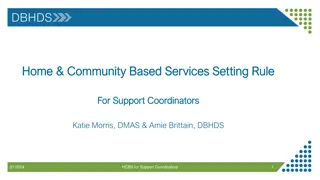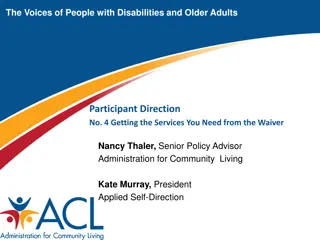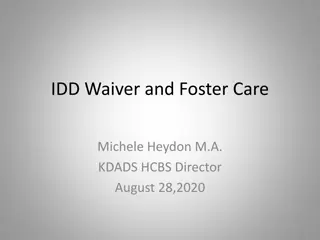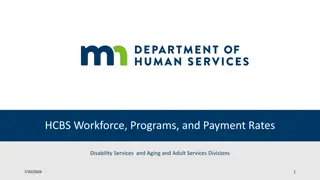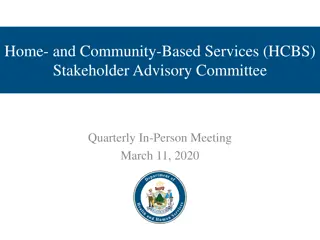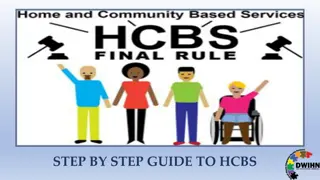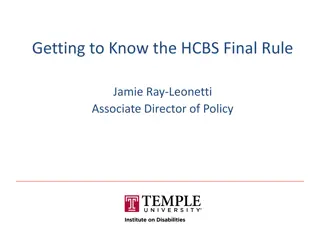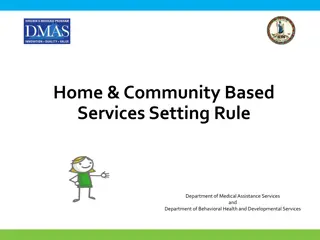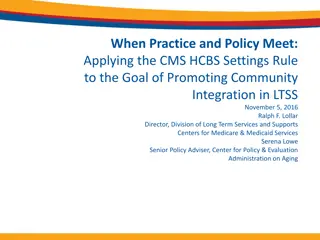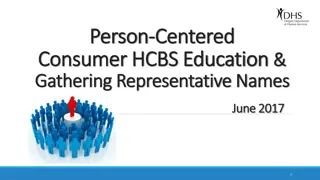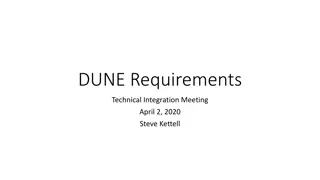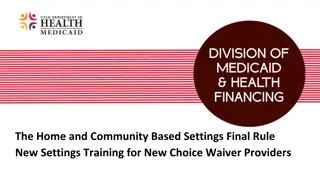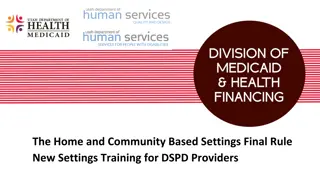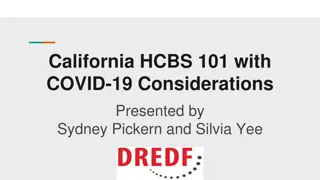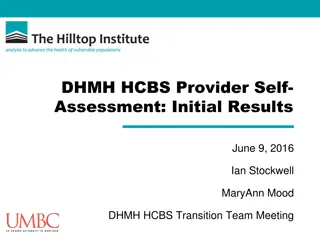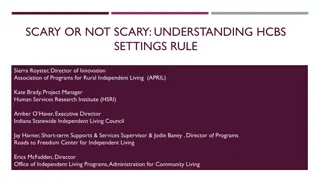Understanding Home and Community-Based Services (HCBS) Requirements
Home and Community-Based Services (HCBS) aim to provide individuals with disabilities the opportunity to live in their communities while ensuring dignity, respect, and choice. Under HCBS regulations, individuals must have access to integrated settings supporting community engagement, employment, and control over personal resources. The settings are selected based on the individual's preferences and needs, as documented in the person-centered service plan. HCBS settings prioritize individual rights, privacy, and freedom from coercion, emphasizing autonomy and independence in decision-making.
- HCBS
- Community-based services
- Individuals with disabilities
- Person-centered planning
- Community integration
Download Presentation

Please find below an Image/Link to download the presentation.
The content on the website is provided AS IS for your information and personal use only. It may not be sold, licensed, or shared on other websites without obtaining consent from the author. Download presentation by click this link. If you encounter any issues during the download, it is possible that the publisher has removed the file from their server.
E N D
Presentation Transcript
Individually-Based Limitations Home and Community-Based Services: Addressing Health and Safety with Individual Protections
HCBS means Home and Community-Based Services. In Oregon, all services authorized by the Office of Developmental Disabilities Services (ODDS) are community-based. What is HCBS? HCBS means that individuals live and receive services in the community. HCBS requirements set rules to assure that people have the opportunity to have lives like everyone else.
Individuals have the opportunity to experience their community The fundamentals of HCBS are: Individuals are treated with dignity and respect; Individuals have genuine choice and self-direction and are free from coercion and restraint
Under HCBS regulations, the settings where an individual resides and receives services must be integrated and support access to the community, including opportunities for the individual to: What are the requirements of HCBS? Seek employment and work in competitive integrated employment settings Engage in community life Control personal resources Receive services in the community
Settings are selected by the individual (or the individual s representative), from among available options. Options must include: Non-disability specific settings An option of a private unit (bedroom) in a residential setting HCBS Requirements Documented in the person-centered service plan; Based on the individual s needs and preferences; For residential settings, based on the available resources of the individual for room and board; For employment and non-residential day services, a non-disability specific setting option must be presented and documented in the ISP The setting options must be:
HCBS settings: Ensure individual rights of privacy, dignity, respect, and freedom from coercion and restraint Optimize, but do not regiment, individual initiative, autonomy, self-direction, and independence in making life choices including, but not limited to: Daily activities Physical environment With whom to interact Facilitate choice regarding services and supports, and who provides the services and supports HCBS Requirements
When an individual lives in the home of their provider, this is considered a provider-owned, operated or controlled residential setting . The home can be owned, rented, or leased by the provider. Provider- Owned, Controlled, or Operated Residential Settings If there is a relationship between the provider and the property owner or controller, this is considered provider- owned, controlled or operated.
In Oregon, provider- owned, controlled, or operated settings are usually: Provider- Owned, Controlled, or Operated Residential Settings Foster Care settings 24-Hour Residential Settings (Group homes) Some Supported Living situations Assisted Living Facilities
A setting is not considered provider- owned, controlled, or operated when: Provider- Owned, Controlled, or Operated Residential Settings An individual lives in a private home that the individual owns, rents, or leases from a third party that has no relationship to the service provider An individual lives in the home of a family member* (even if the family member is a paid caregiver) *A family member is a person legally related to the individual by blood, adoption, or marriage.
There are additional requirements for HCBS settings when the individual lives in the home of their provider. These rules are: Specific Rules for Provider- Owned, Controlled or Operated Residential Settings The setting is physically accessible to the individual There is a Residency Agreement in place for each individual addressing protections for the individuals and the eviction and appeal processes Each individual has privacy in his or her own unit
Rules continued: Specific Rules for Provider- Owned, Controlled or Operated Residential Settings Units (bedrooms) have doors lockable by the individual, with only the individual and appropriate staff having keys In shared bedrooms, individuals have a choice in roommates Individuals have the freedom to decorate and furnish their bedrooms Individuals may have visitors of their choosing at any time Individuals have the freedom and support to control their schedule and activities Individuals have the freedom and support to have access to personal food at any time
Specific Rules for Provider- Owned, Controlled or Operated Residential Settings Schedule/Activities Individuals have the freedom and support to control personal schedule and activities. Access to Food Individuals have the freedom and support to have access to personal food at any time. Decorations Individuals may furnish and decorate their bedroom or unit within the Residency Agreement. Locks Roommates Visitors Individuals have locking bedroom doors with only the individual and appropriate staff having keys. Individuals sharing bedrooms have a choice in roommate. Individuals may have visitors of their choosing at any time. The freedoms and protections above can only be limited if there is a current, significant health and safety risk.
Individually-Based Limitations (IBL s) When and How They Apply
There may be situations when an individual needs restrictions placed on certain Home and Community-Based protections due to a serious health or safety risk. What are Individually- Based Limitations?
An Individually-Based Limitation is a restriction, prohibition, or strategy that serves as a barrier to the following Home and Community- Based freedoms of an individual residing in a residential service setting: What are Individually- Based Limitations? Freedom to furnish and decorate the bedroom Visitors of the individual s choosing at any time Control of personal schedule and activities Access to personal food at any time Choice in bedroom roommate Locks on bedroom (unit) door
It is also considered a limitation when those responsible to provide supports withhold necessary assistance, resulting in the individual being limited in enjoying an HCBS protection. Individually- Based Limitations
To address current significant health and safety risks; Individually- Based Limitations may only be applied: With the consent of the individual (or their guardian); and When the entire process identified in rule (OAR 411-004-0040) is followed.
Lockable Bedroom or Unit Doors Choice of Roommate Individually- Based Limitations may only be applied to these HCBS protections: Access to Personal Food Decorating and Furnishing Control Schedule and Activities Visitors
Essential Elements to Consider if an Individually- Based Limitation is appropriate Active Threat (Behavior or Medical Issue or Situational) No Less Restrictive Alternative Available Significant Health and Safety Risk Current Issue
Individually- Based Limitations: Best Practice Guidance An individual: Although access to food has a potential risk, an Individually- Based Limitation is not necessary nor appropriate in this situation. However, the individual is unable to independently access food and does not request access to food. There is a significant safety risk if the individual accesses solid foods and attempts to eat. uses a g-tube; No restriction is being put upon the individual to limit access to food. does not ingest solid foods orally; and has an identified risk of aspiration. Example
When should an Individually- Based Limitation be used? Teams should support individuals to have the opportunity to fully enjoy the benefits and characteristic of community living. This includes pro-active planning, education, and identification of opportunities with the individual.
When should an Individually- Based Limitation be used? When pro-active approaches and positive interventions are not enough to address an individual s safety Limitations may only be implemented as a last resort, Positive, pro-active support strategies should always be considered and tried prior to the implementation of a limitation. meaning there is no other less restrictive option to address the health and safety risk(s). a limitation may be an option.
Limitations generally should be reactive, meaning that a limitation is proposed and applied in response to a current and active threat to health and safety. Individually- Based Limitations: Best Practice Guidance Limitations should not be applied in anticipation of a potential threat to health and safety.
An individual choosing to place restrictions on themselves without intervention from others to enforce the restriction is not considered a limitation. Individually- Based Limitation- What is not a limitation? Example: An individual may decide that they want to eat less junk food to improve health. The individual s goal of improved health and the decision to not eat food that is unhealthy is not necessarily a limitation. The action is within the individual s control and is not imposed upon the individual by another party. The individual is not restricted by anyone else preventing them from eating junk food.
The intervention (action or non-action) Individually- Based Limitation- What is a limitation? by a care provider is a critical determining factor if something is a limitation.
Providers are responsible to address the health and safety needs of individuals they serve. Providers may intervene in emergency or reasonably unanticipated situations to address health and safety. Individually- Based Limitation- What is not a limitation?: Unanticipated Situations The HCBS rules should not stop a provider from responding to unanticipated health or safety risk situations. However, if the situation is reasonably anticipated and/or the intervention becomes routine, then this is an individually-based limitation and must be treated as such through the formal process.
When a child resides in a foster care or 24- hour residential service setting, the provider is responsible to act in the role of a parental figure. Individually- Based Limitation- What is not a limitation? A provider may apply or limit an HCBS protection in a manner that is consistent with typical parenting practice for a child of the same age without a disability. Consideration for Children in Residential Settings If structure is imposed that is more restrictive than typical parenting practice for a non- disabled child of the same age, then this structure is considered a limitation and the requirements for process and documentation apply (OAR 411-004-0020(3))
Requirements for Individually- Based Limitations OAR 411-004-0040 When a limitation is applied based on a current, significant health and safety risk, an ODDS-approved form must be incorporated in the person-centered planning process.
The Individual Support Plan (ISP) must document all of the following: The need justifying the limitation; The positive interventions used prior; What has been tried but didn t work; A description of the limitation that is proportionate to the assessed need; Regular collection and review of data measuring the ongoing effectiveness of the limitation; Time limits for reviews of the limitation to determine if the limitation remains necessary (minimum annual basis); The informed consent of the individual, or the individual s legal guardian; An assurance the limitation will not cause harm to the individual. Requirements for Individually- Based Limitations OAR 411-004-0040
Individually- Based Limitations: Documentation Use this form (attach it to the ISP)
Individually- Based Limitations: Documentation Use this form (attach it to the ISP)
Individually- Based Limitations: Documentation Use this form (attach it to the ISP)
Individually- Based Limitations: Documentation Use this form (attach it to the ISP)
Individually- Based Limitations: Responsibilities of the Services Coordinator Completing the Consent to Individually- Based Limitation form (including ensuring that all of the requirements are in place) Providing a copy of the form to the individual and the provider (the form should also be attached to the ISP) Monitoring the usage and tracking of the Individually- Based Limitation Facilitating the limitations discussion
Individually- Based Limitations: Responsibilities of the Residential Service Setting Provider Regular collection and review of data to measure the ongoing effectiveness and continued need for the limitation Requesting a review when a new limitation, or change of an existing limitation, appears to be needed Maintaining a copy of the completed and signed form documenting the consent to the limitation
When a team is considering a limitation to address a significant health and safety risk for one individual in the home, the limitation may not result in a barrier or limit for other individuals in the home who do not require such structure. Individually- Based Limitations: Best Practice Guidance For example: One individual in the home may need limited access to foods based on behavioral and medical issues. If the team determines that the least restrictive and most appropriate structure for the individual is to lock the fridge, this practice may not result in other individuals experiencing limited access to personal foods at any time when those other individuals do not require such restrictions.
An individual needs access to foods limited based on behavioral and medical needs. Individually- Based Limitations: Best Practice Guidance This practice may not result in a barrier to other individuals having access to personal foods at any time if they do not require such restrictions. The team determines the least restrictive, most appropriate structure is to lock the fridge. Example
An Individually-Based Limitation may not be applied without an individual s consent. Supported decision- making may be used to assist the individual in understanding and consenting to a limitation. Consent to Individually- Based Limitations In Oregon, individuals are presumed to have capacity unless otherwise determined by a court. If an individual has a guardian, then the individual s guardian may consent to a limitation.
A guardian, designated representative, or team cannot override an individual who objects to a limitation when the individual has the capacity to make an informed decision. Consent to Individually- Based Limitations An Individually-Based Limitation cannot be used prevent bad choices.
Individually-Based Limitations & The ISP process Incorporating IBL Requirements into the ISP Planning Process
The Risk Identification Tool and Risk Management Plan are key components of the ISP which aid in the identification of Individually-Based Limitations. When a limitation is considered and/or consented to, this should be indicated on the Risk Management Plan by marking the appropriate boxes. Ideally, Individually- Based Limitations are identified through the natural course of the ISP planning process. IBL s and the ISP
IBLs and the ISP (Risk Management Plan)
An individually-based limitation can be identified or proposed by anyone on the individual s team at any time. It is likely that the individual s service provider will initiate a request for the team to consider a limitation. Can an Individually- Based Limitation be identified outside of the ISP process? The Services Coordinator must facilitate the process, ensuring that: The proposed limitation is the most appropriate and least restrictive means to address the identified assessed need of the individual The required steps and documentation are completed prior to the implementation of the limitation The individual consents to the limitation
Individually-Based Limitations: Timelines
September 2018: March 2017- February 2018: IBLs are included in ISPs Final deadline for full compliance by providers October 2016- December 2016: IBL Trainings Individually- Based Limitations will begin rolling out in January 2017 January 2017: IBLs begin being implemented for ISPs effective March 2017 or later March 2018- Ongoing: New IBLs are implemented as needed New limitations that are identified after an individual s 2017 ISP must go through the formal process before being implemented.
The ISP planning process should be utilized to address current health and safety needs of individuals. Individuals requiring limits prior to IBL roll-out The Consent to Individually-Based Limitations form is not required prior to the roll out in 2017. (For ISP s effective prior to March 1, 2017) Structures in place that could be a considered a limitation should be: Identified in the ISP (Risk Management Plan); Supported by an assessed need; Consented to by the individual or their guardian.
Individually-Based Limitations: Other Questions
Individual (or the guardian) does not consent. Limitation is not supported by a specific assessed need related to a significant health and safety risk. Limitation is being implemented for convenience of the provider or as a means to avoid implementing changes required by HCBS. Alternative, less intrusive methods of addressing the health and safety risk(s) have not been explored and ruled out. Individually- Based Limitations may not be implemented when the: When is an Individually- Based Limitation not allowed?
Individually-Based Limitations are only applicable to the six identified HCBS protections for individuals residing in provider-owned, controlled, or operated residential settings. When is an Individually- Based Limitation not an Individually- Based Limitation? Individuals may have structures and strategies identified in their plan to address other health and safety issues. Such strategies may exist, but they are not considered Individually-Based Limitations. Additionally, structures and supports that individuals may have identified in their Risk Management Plan are not required to fall into one of the six Individually-Based limitation categories to exist.
Non-transferable; Specific and unique to each residential setting; Not automatically transferred with an individual to a new residential setting. Individually- Based Limitations are: Other Restrictions Whenever an individual in a residential setting moves, limitations must be re-done and cannot be automatically adopted in the new home environment.




